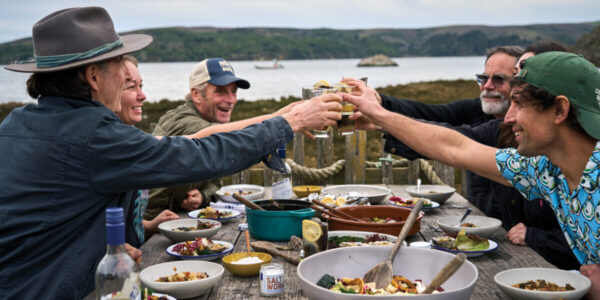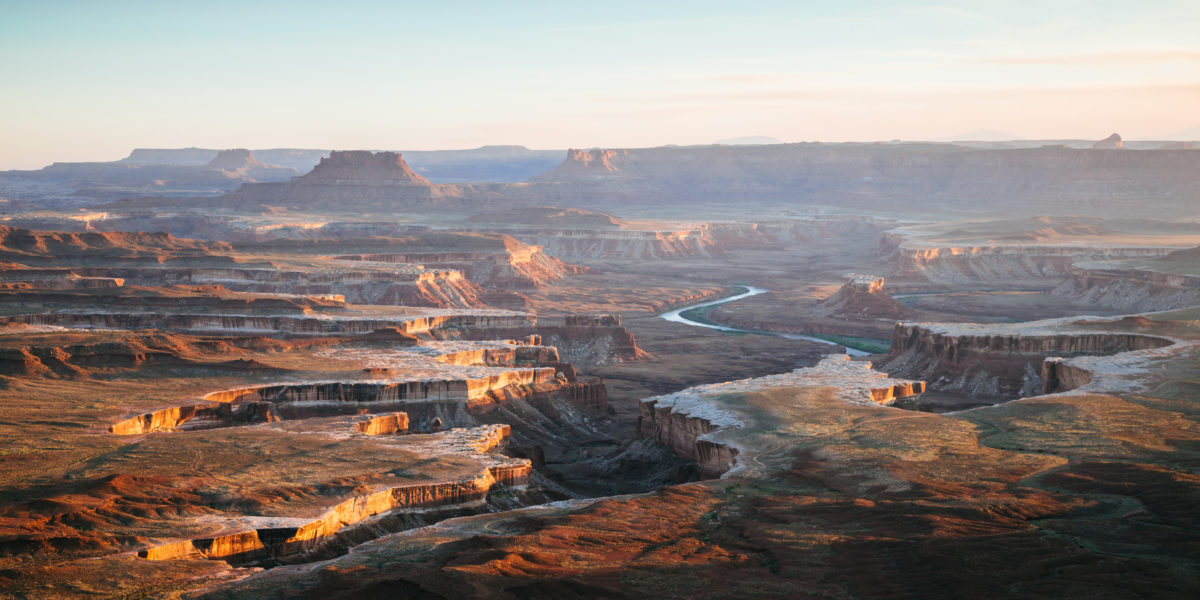
Utah’s Green River Is Everything a Western Waterway Should Be
On a 730-mile run through this far-off, achingly beautiful, seemingly wild river, author Heather Hansman discovers the future of water in the West

Matteo Colombo/Getty Images
The neck-craning canyons of the Gates of Lodore spring out of nowhere, at odds with the rolling bluff of Browns Park. After the mellow undulation of the park, the walls of the canyon pinch back in, and the red rocks of the Uinta Mountain Group fold up, pushing skyward. The water picks up speed as soon as we get on the river, and we paddle into a stiff, persistent headwind. You’re ruled by wind and light in the canyons, and the sun diffuses as we get deeper into this one. I keep spinning my face skyward, trying to get a look at the top.
The evening before, I’d shown up at the O.A.R.S. rafting outfitter’s boathouse in Vernal to prep for a river trip through Lodore. Permits for the 44-mile-long section of the Green River are among the most sought-after in the country because those canyons hold sustained class IV rapids.
There have been eyes on the Green River, the most significant tributary of the Colorado River, since white people first spread out across the United States. This particular river was a pivot in the opening of the West. It was everything I thought a western river should be: far-off, achingly beautiful, seemingly wild. I eventually decided I wanted to run the 730-mile length of the Green, from the glaciers of Wyoming to the desert canyons of Utah, to see if I could understand the complexity of the way rivers are used.
Having been on the river for more than a month I’ve grown accustomed to quickly packing my own boat and bags. Now, I’ve dropped into these people’s vacation and the Tetris of tourist gear feels unwieldy and slow. The Green comes into Vernal from the northwest. In four days we’ll take out 20 minutes from town, but the river bisects Dinosaur National Monument and there aren’t any roads across the monument’s steep canyons, so we have to circle a few hours around to the put-in. We drive into Colorado, across the top of the Tavaputs Plateau, and stop just over the state line in Dinosaur to load up on booze. It’s not even 9 a.m., but the liquor store, one of the few businesses in town, is open and full of the grease of river trips: boxed wine and canned beer.
There is a crush of rubber and gear at the boat ramp—dry bags strewn outside the pit toilets, sunblock everywhere. Flaming Gorge is still releasing full flows to keep the reservoir from overtopping the dam, so the water is high. When we stop to scout Disaster Falls, my guide for the day, Bob Brennan, tells me he’s never been down the river at this level before.
I’m not naturally patient, but I can watch water move for a long time. Standing on the shore at Disaster, watching the river pillow up and crash through wave trains, I can feel a familiar tightening in my chest. I know athletes who visualize their events to prepare themselves. Scouting whitewater is that same kind of meditation and projection, but it’s more visceral, because you can see the muscle of the river and all the ways it can mess you up. From the bank it’s just as easy to visualize what can go wrong as what can go right.
River-running done right is all grace and ease, a few clean oar strokes here or there, minimal time spent fighting the current. But in big water there are a million ways to miss your mark and find yourself pulling against the waves, fighting hard.
River Pioneers
In the 1930s, before the dam went in and before inflatable boats like the rafts we’re in now were invented, the early wild men of paddling took wooden boats through the rapids of the Green—first to prove they could run it, then to explore it, then to make money by bringing clients into the canyons. Around the same time, Vernal-born carpenter Bus Hatch, who was known for his drinking habits and disregard for his own physical safety, started running the Green through the Gates of Lodore in wooden boats with names like What’s Next and Who Cares.
He modeled them on Galloway-style boats, the first designed to be rowed backward, which were named after their designer, Nathaniel Galloway. Bus learned about Galloway boats after he helped Nathaniel’s son Parley jump bail in the Uinta County Jail. But Bus was more of an opportunist than a criminal, and after gaining some recognition for taking friends boating, he realized that strangers would pay him to bring them down the river.
Recreational river-running grew in parallel with both the explosion of dam building across the West and the mounting interest in environmental protection. The industry changed after World War II, when boaters realized they could recycle military pontoon boats. The new rubber rafts were cheaper and more resilient than the wooden boats and could hold more people and gear. In 1953, Bus Hatch was given the first National Park Service river-concession permit in the country and allowed to run commercial trips through Dinosaur National Monument. By the mid-1950s he was taking hundreds of people through the canyons of the Green and exploring rivers in Idaho and Arizona. Other companies sprang up in Vernal after that.
Conservation Heroes
The river still feels wild and lonely now, but there are guidebooks, tourists’ GoPro videos on YouTube, and a sense that we’re retracing other people’s steps. I envy the way those early paddlers explored these canyons. The history, and the myths about people like Bus, make me feel like I missed out on the best days of river-running.
I’m jealous in part because I know how wild I felt when I first started boating at 18. When I moved to Colorado after college, I started guiding because I had an unfettered desire to be outside, but I got sucked in because of the charge and the slow-rolling way that being on the river binds you to people. After I fell in love with paddling I started to learn about all the nonobvious ways that rivers are important. Guiding tourists was my line in. For me, the world of commercial river-running, even though it sometimes feels contrived, is an important part of river access.
Here on Lodore, that sense of value feels clear as we slip into the day-to-day routine. Coffee and breakfast, reloading the boats, the first flash of water to the face. Lunch, and an eventual ache from paddling, then beers and books on the beach at night. Everyone starts to open up because they have time and space.
In the morning we paddle into Echo Park, where the Green joins up with the Yampa. Even though it only flows in a short spring-snowmelt pulse, the Yampa brings in about the same amount of water that the dam-controlled Green does all year. The confluence is also breath-grabbingly beautiful.
This area was almost underwater once. In 1941, it was slated to become a reservoir. By building one dam in Whirlpool Canyon, just downstream of the confluence, and another downstream of that, at Split Mountain, the Bureau of Reclamation would have created a 6,400,000-acre-foot reservoir flooding the Yampa and Lodore canyons well upstream into Dinosaur National Monument, which had been designated in 1915.
A Win for Conservation
In 1952, the Sierra Club’s first executive director, David Brower, took a trip down the Yampa with Bus and Don Hatch. He said he’d never had an equal scenic experience.
The Bureau of Reclamation was pushing hard for the Echo Park Dam because it had calculated that a reservoir there would lose less water to evaporation than other proposed downstream reservoirs, but Brower didn’t buy it. In 1954, he dragged a chalkboard into a U.S. House of Representatives subcommittee to show them that the bureau’s estimates were faulty. He then started a letter-writing campaign, commissioned Wallace Stegner to edit a book called This Is Dinosaur, and paid the Hatches to take other politicians down the river.
His campaign worked. In 1955, the Echo Park Dam was removed from the Colorado River Storage Project. Because of Brower, the sandstone towers of Echo Park are still visible, shimmering pink in the summer light above the river. We stop for lunch on the downstream side of the confluence with the Yampa, standing ankle deep in the rushing water.
Places are complicated things to love. Conservation is often a job of making bargains, of trying to gauge what to give up and what is irreplaceable. Brower believed in the value of beauty and awe, and so do we, even though we all struggle to articulate it when we sit around the fire at night telling stories, strangers now bound together by days in the canyon.
Heather Hansman is a Seattle-based writer. This is an excerpt from her book Downriver: Into the Future of Water in the West ($25), to be published April 2 by University of Chicago Press. To learn more, read her tips on protecting our rivers both on and off the water.

How to Run the Green
Guided departures are typically available late May through mid-September. Many of the rapids through Lodore and Desolation Canyons are class III, with scenery that rivals the Grand Canyon. Here are three trusted outfitters.
Adrift Dinosaur
Specialty trips feature guests like Patrick Tierney, author of an award-winning book about Colorado’s Yampa River. Adrift Dinosaur offers both rafting and SUP trips starting in Colorado on the Green or Yampa rivers and ending at Split Mountain Campground in Utah. Four-day SUP trips from $1,950 and rafting from $859.
Holiday River Expeditions
Holiday, a Utah-based company, has been guiding for 50-plus years in the West. Five- and six-day trips cover an 84-mile stretch of the Green that runs through Desolation Canyon. On the river, you’ll tackle 60 rapids. On shore, you’ll spot ancient petroglyphs and bighorn sheep. Five-day trips from $1,180.
OARS
Author Heather Hansman ran the Green River through the Gates of Lodore with pioneering rafting company OARS. Dinosaur National Monument is the backdrop for three- to five-day family-friendly itineraries. Paddling is broken up with hikes and comfy catered meals on sandy beaches. Three-day trips from $699.
